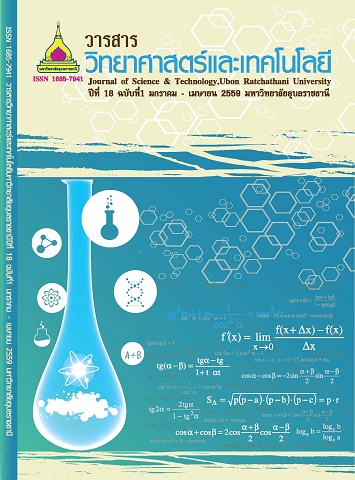แก้วโซดาไลม์ผสมกับเถ้าลอยลิกไนต์ซิลิกาต่ำผลิตแก้วเซรามิก
Main Article Content
บทคัดย่อ
นำเถ้าลอยมีซิลิกาต่ำที่เป็นของหลงเหลือตกค้างจากการเผาไหม้ของลิกไนต์ใช้เป็นสารเติมแก่แก้วโซดาไลม์แล้วอัดขึ้นรูป เผาผนึกผงเพื่อผลิตเป็นแก้วเซรามิก ก่อนอัดขึ้นรูปบดแก้วโซดาไลม์และเถ้าลอยด้วยหม้อบด เป็นเวลา 3 ชั่วโมง และ 2 ชั่วโมง ตามลำดับ คัดขนาดแก้วโซดาไลม์และเถ้าลอยที่อนุภาคเล็กกว่า 75 ไมครอน เถ้าลอยแทนที่แก้วโซดาไลม์บดในอัตราส่วนร้อยละ 20 30 40 และ 50 โดยน้ำหนัก ตัวอย่างทดสอบอัดขึ้นรูปทรงกระบอกสูง 17 มิลลิเมตร เส้นผ่านศูนย์กลาง 15 มิลลิเมตร ตัวอย่างดิบนำไปเผาที่อุณหภูมิ 750 850 และ 950 องศาเซลเซียส คงไว้เป็นเวลา 1 ชั่วโมง ทดสอบสมบัติทางกายภาพและสมบัติเชิงกลประกอบด้วย ความหนาแน่นรวม การหดตัวเชิงปริมาตร การดูดซึมน้ำ ความต้านทานไฟฟ้าจำเพาะ ความแข็งแบบชอร์ กำลังอัดที่อุณหภูมิปกติและที่อุณหภูมิ 80 องศาเซลเซียส นอกจากนี้ตรวจสอบการทนต่อสารเคมี ความต้านทานการเปลี่ยนอุณหภูมิอย่างฉับพลัน และวิเคราะห์ชนิดแร่และโครงสร้างจุลภาคด้วยวิธีการเลี้ยวเบนรังสีเอกซ์และกล้องจุลทรรศน์อิเล็กตรอนแบบส่องกราดตามลำดับ ผลการทดลองพบว่าแก้วเซรามิกผสมเถ้าลอยร้อยละ 40 เผาที่อุณหภูมิ 850 องศาเซลเซียส ให้กำลังอัดสูงสุดคือ 44.04 เมกะพาสคัล ที่อุณหภูมิห้อง และ 39.64 เมกะพาสคัล ที่อุณหภูมิ 80 องศาเซลเซียส ความหนาแน่นรวม 1.72 กรัมต่อลูกบาศก์เซนติเมตร รูปแบบการเลี้ยวเบนรังสีเอกซ์ของตัวอย่างที่เด่น ระบุว่า วัฏภาคแร่สำคัญประกอบด้วย แร่คริสโทบาไลต์ไดออปไซด์ และโวลลาสโทไนต์
Soda-Lime Glass Mixed with Low Silica Lignite Fly Ash to produce Glass-Ceramics
Fly ash (FA) with low silica, a pollutant residue from the combustion of lignite, was utilized as an additive to a powder of soda-lime glass (SLG) produced glass-ceramics by powder technology. The SLG and FA were ground in a ball mill for 3 h and 2 h respectively. The particle sizes of SLG and FA were finer than 75 micron. The SLG was replaced partially in proportions of 20, 30, 40, and 50 wt.% FA. Then specimens were uniaxially pressed into a cylindrical form 15 mm in diameter and 17 mm in length. The green specimens were fired at different temperatures of 750, 850 and 950oC and held for 1 h. Physical and mechanical properties containing bulk density, volumetric shrinkage, water absorption, electrical resistivity, Shore hardness, and compressive strengths at an ambient temperature and 80oC were determined. Chemical resistance and thermal shock was also performed. Crystallinity and micro-structural properties were analyzed under the X-ray diffraction (XRD) method and scanning electron microscopy respectively. The glass-ceramic specimen containing 40% FA with firing at 850oC showed the highest compressive strength of 44.04 MPa at an ambient temperature and 39.64 MPa at a temperature of 80oC and bulk density of 1.72 g/cm³. XRD patterns of the dominant specimens indicated the major mineral phases including cristobalite, diopside, and wollastonite
Article Details
บทความที่ได้รับการตีพิมพ์เป็นลิขสิทธิ์ของ วารสารวิทยาศาสตร์และเทคโนโลยี มหาวิทยาลัยอุบลราชธานี
ข้อความที่ปรากฏในบทความแต่ละเรื่องในวารสารวิชาการเล่มนี้เป็นความคิดเห็นส่วนตัวของผู้เขียนแต่ละท่านไม่เกี่ยวข้องกับมหาวิทยาลัยอุบลราชธานี และคณาจารย์ท่านอื่นๆในมหาวิทยาลัยฯ แต่อย่างใด ความรับผิดชอบองค์ประกอบทั้งหมดของบทความแต่ละเรื่องเป็นของผู้เขียนแต่ละท่าน หากมีความผิดพลาดใดๆ ผู้เขียนแต่ละท่านจะรับผิดชอบบทความของตนเองแต่ผู้เดียว


